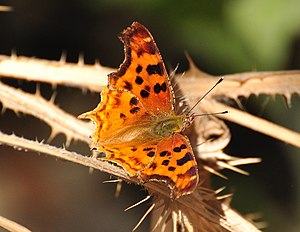Polygonia satyrus
| Polygonia satyrus | ||||||||||||
|---|---|---|---|---|---|---|---|---|---|---|---|---|

Polygonia satyrus , spring form |
||||||||||||
| Systematics | ||||||||||||
|
||||||||||||
| Scientific name | ||||||||||||
| Polygonia satyrus | ||||||||||||
| ( Edwards, WH , 1869) |
Polygonia satyrus ( Syn .: Nymphalis satyrus ) is a butterfly ( butterfly ) fromthe noble butterfly family (Nymphalidae), which occurs in North America.
features
butterfly
The moths usually reach a wingspan of 45 to 64 millimeters. The wings are strongly serrated on the outer edge and are variable in color. The upper side of the wing is light yellow-orange, on the front wing there are two black round spots one behind the other near the middle of the rear edge. The upper side of the hind wing always has a black spot in the middle and no dark border. The pale submarginal spots mottle into the yellow center. The light and dark gold-brown underside of the wing has a slightly lighter, broad band in the middle. This is straighter than with Polygonia comma , as is the C-symbol in the middle of the hind wing.
egg
The egg is greenish in color. It is deposited individually, in groups or in small piles on the underside of young leaves of the food plant.
Caterpillar
The prickly adult caterpillar has a blackish basic color and a greenish-yellow upper side. Dorsally, weakly pronounced V-shaped markings can be seen, except directly behind the head. Behind the stigmata there are orange lines, underneath an irregular pale yellow band with yellow spines runs laterally .
Doll
The pupa is light brown and sometimes dorsally yellow in color. It has a very pronounced hump and two short tips on the head. A few golden spots shimmer on the saddle.
Similar species
Polygonia satyrus resembles many species of Polygonia due to the drawing on the upper side of the wings , in particular:
- The C-butterfly ( Polygonia c-album ), which is native to Europe, North Africa and Asia and thus does not form any geographical overlap.
- Polygonia faunus is distinguished by a series of green dots on the underside of the hind wings.
- Polygonia comma can be distinguished by a strong marbling on the underside of the hind wing and rarely has a black round spot near the cell of the forewing.
- Polygonia interrogationis is significantly larger, has a two-part C-symbol and shows a more orange or brownish color on the upper side of the forewing.
distribution and habitat
Polygonia satyrus is found in the southern and western provinces of Canada and in the northern and western United States . The distribution extends from the southern Yukon , the Northwest Territories , British Columbia and Alberta in the west over southern Canada to Nova Scotia and in the USA over the Great Lakes to northern New England . To the south, the distribution extends in the west to Baja California , southern Arizona and southwestern New Mexico .
Polygonia satyrus lives in valleys, in wooded prairie gorges, swamps, forests on rivers and on damp forest edges.
Way of life
The species usually forms two generations per year. The moths of the first generation fly from late June to late August, the second in September. They hibernate as moths and fly until May of the following year (in Colorado, Nevada, and Saskatchewan ). In California, three generations fly from February to hibernation in November. In Nova Scotia and Newfoundland only one generation flies from the end of July and winters until next June.
Older caterpillars form nests on the underside of the leaves by biting the petiole so that it snaps off. The leaf margins are pulled down and spun together, as P. comma does. The caterpillars feed on a variety of different plants, such as the nettle family (Urticaceae), in particular greater nettle ( Urtica dioica ssp. Gracilis and holosericea ), willow family (Salicaceae) in Arizona or mulberry family (Moraceae) such as the real hop ( Humulus lupulus ).
The moths suck nectar from flowers, plant saps and minerals from mud. The males sit in lowlands from noon to late afternoon and wait for females to fly by. The overwintering moths take up food in autumn and usually do not mate until the next spring.
swell
Individual evidence
- ^ A b c Butterflies and Moths of North America
- ↑ a b c d e James A. Scott: The Butterflies of North America , Stanford University Press, Stanford CA., 1992, ISBN 0-8047-2013-4 , pp. 285f
literature
- James A. Scott: The Butterflies of North America , Stanford University Press, Stanford CA., 1992, ISBN 0-8047-2013-4 , pp. 285f
Web links
- butterfliesofamerica.com - Photos
